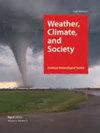气候和人口变化下美洲原住民的未来暴雨和洪水风险:以俄克拉荷马州为例
IF 1.9
4区 地球科学
Q3 ENVIRONMENTAL STUDIES
引用次数: 0
摘要
气候变化给不同社区带来了不公平的风险。在美国的有色人种群体中,印第安人脱颖而出,因为(1)他们需要资源来维持有弹性的国家;(2)他们通过应对当地气候相关挑战的经验,开发了基于自然的解决方案,可以为整个社会提供深刻的见解。预测美洲原住民的气候风险对于评估未来的风险和支持他们的气候准备就绪的国家至关重要;然而,一直缺乏可用的信息。在这项研究中,我们预测了俄克拉荷马州部落国家的三种气候灾害——强降雨、两年一次的洪水和山洪暴发。为了分解到部落管辖区,我们使用了一个耦合的4公里区域气候模型和1公里的山洪预报模型。应用危害暴露-脆弱性风险框架,将高排放情景下的气候和人口变化结合起来。研究发现:(1)俄克拉何马州土著居民是最脆弱的群体;(2)强降雨和两年洪涝灾害危险性分别显著增加501.1%和632.6%,山洪灾害危险性适度增加296.4%;(3)俄克拉何马州印第安人在强降雨、两年洪水和山洪暴发中的风险分别比普通人群高68.0%、64.3%和64.0%;(3)对比气候和人口变化,人口增长导致的气候灾害风险大于气候变化;(4)新兴部落国家的人口预计将增加10倍以上,因此极易受到极端气候的影响。这项研究可以提高人们对气候变化影响的认识,并引起人们对少数群体气候不公正问题的关注。本文章由计算机程序翻译,如有差异,请以英文原文为准。
Future Heavy rainfall and flood risks for Native America under climate and demographic changes: A case study in Oklahoma
Abstract Climate change has posed inequitable risks to different communities. Among communities of color in the US, Native Americans stand out because (1) they desire resources to sustain resilient nations; and (2) they have developed nature-based solutions through experiences with local climate-related challenges, which can provide deep insight for the whole society. Projection of climate risks for Native Americans is essential to assess future risks and support their climate-ready nations; yet, there has been lack of useable information. In this study, we projected three climate hazards – heavy rainfall, two-year floods, flash floods – for tribal nations in Oklahoma. To break down into tribal jurisdictions, we utilize a coupled regional climate model at 4 km and flash flood forecast model at 1 km. A hazard-exposure-vulnerability risk framework is applied to integrate both climate and demographic changes in a high-emissions scenario. It is found that: (1) indigenous people are the most vulnerable community in Oklahoma; (2) heavy rainfall and two-year floods have marked increases in risks at 501.1% and 632.6%, respectively, while flash floods have a moderate increase (296.4%); (3) Native Americans bear 68.0%, 64.3%, and 64.0% higher risks in heavy rainfall, two-year flooding, and flash flooding than general population in Oklahoma; (3) comparing climate and demographic changes, population growth leads to greater climate hazard risks than climate change; and (4) Emerging Tribal Nations are projected to have 10 times more population, resulting in great exposures to climate extremes. This study can raise awareness of the impact of climate changes, and draw attention to address climate injustice issues for minoritized communities.
求助全文
通过发布文献求助,成功后即可免费获取论文全文。
去求助
来源期刊

Weather Climate and Society
METEOROLOGY & ATMOSPHERIC SCIENCES-
CiteScore
3.40
自引率
13.60%
发文量
95
审稿时长
>12 weeks
期刊介绍:
Weather, Climate, and Society (WCAS) publishes research that encompasses economics, policy analysis, political science, history, and institutional, social, and behavioral scholarship relating to weather and climate, including climate change. Contributions must include original social science research, evidence-based analysis, and relevance to the interactions of weather and climate with society.
 求助内容:
求助内容: 应助结果提醒方式:
应助结果提醒方式:


